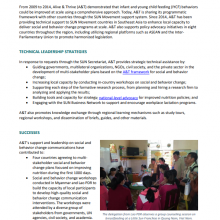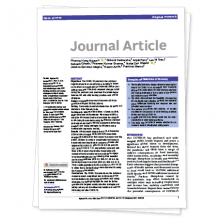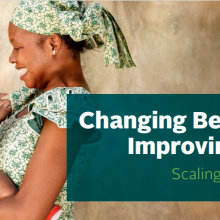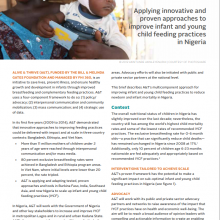Brief
Feb 02 2017

Briefing note: SUN technical assistance in Southeast Asia
In Southeast Asia, A&T shares its programmatic framework with other countries through the SUN Movement support system.
Journal article
Jan 11 2017

The association of a large-scale television campaign with exclusive breastfeeding prevalence in Viet Nam (Nguyen TT., 2017. American Journal of Public Health)
Alive & Thrive (A&T) used qualitative research methods to examine the association between exposure to breastfeeding television spots and exclusive breastfeeding (EBF) between 2011 and 2014 in Viet Nam.
Journal article
Oct 25 2016

Impacts on breastfeeding practices of at-scale strategies that combine intensive interpersonal counseling, mass media, and community mobilization: results of cluster-randomized program evaluations in Bangladesh and Viet Nam (Menon P., 2016. PLOS Med)
In Bangladesh and Viet Nam between 2009–2014, Alive & Thrive (A&T) worked to improve breastfeeding practices through intensified interpersonal counseling (IPC), mass media (MM), and community mobilization (CM) intervention components delivered at scale in the context of policy advocacy (P
Journal article
Oct 18 2016

Exposure to large-scale social and behavior change communication interventions is associated with improvements in infant and young child feeding practices in Ethiopia (Kim SS., 2016. PLOS One)
The Alive & Thrive (A&T) initiative aimed to improve infant and young child feeding (IYCF) practices in Ethiopia through large-scale implementation of social and behavior change communication interventions in four regions of Ethiopia.
Brief
May 23 2016

Alive & Thrive: Changing behaviors, improving lives
Describes the Alive & Thrive initiative by outlining how and why we began, what we’ve achieved and how we’ve evolved today. Also illustrates the four component framework that we use to scale up nutrition.
Brief
Feb 19 2016

Applying innovative and proven approaches to improve infant and young child feeding practices in Nigeria
The overall nutritional status of children in Nigeria has slightly improved over the last decade; nevertheless, the country still has among the world’s highest child mortality rates and some of the lowest rates of recommended IYCF practices.

